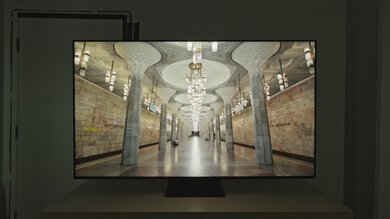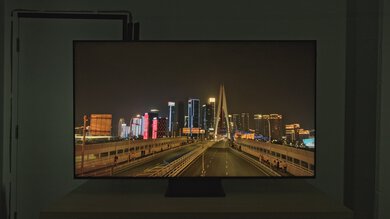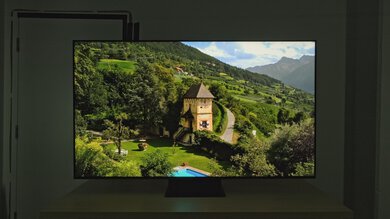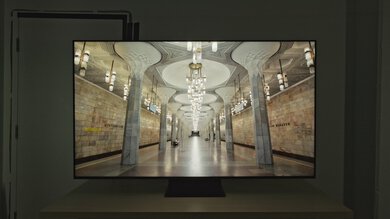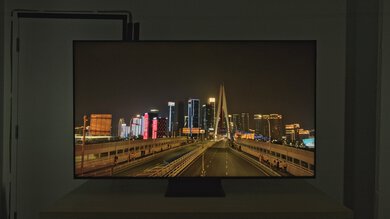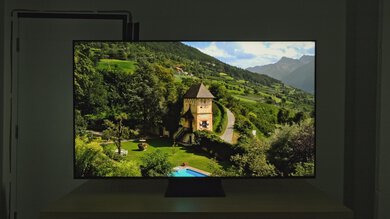The TCL QM851G is the highest-end offering in TCL's 2024 North American QLED lineup and sits above the TCL QM751G. It uses TCL's AIPQ Engine Gen3 processor and is advertised as being over twice as bright as its predecessor, with up to 5000 dimming zones depending on the size. The TV is loaded with features like Dolby Vision and HDR10+, HDMI 2.1 bandwidth, 4k @ 144Hz, 1080p @ 240Hz, and VRR support. It uses the Google TV interface that's loaded with apps and has other smart features like voice control, and it comes with a backlit remote. It has a built-in 2.1.2 channel ONKYO speaker system and supports Dolby and DTS advanced audio formats. We bought and tested the 65-inch model, but it's available in four different sizes: 65, 75, 85, and 98 inches. It's been replaced in 2025 by the TCL QM8K.
Our Verdict
The TCL QM8 is great for mixed usage. It's extremely bright in SDR and HDR, making it suitable for any room context and for watching any content, as highlights really pop on this model. While its reflection handling struggles a bit with direct sources of light, the TV is so bright that it still easily overcomes most glare, although it will be distracting in darker scenes. It has excellent black levels, so its blacks stay deep when bright highlights are also on screen. It's also very colorful overall, so ultimately, it's a stand-out choice for image quality. Unfortunately, it falters when it comes to accuracy in HDR, as its colors aren't nearly as accurate as in SDR, and it struggles with its HDR brightness accuracy. It's a very good TV for gamers due to its fast pixel transitions for an LED model, but it's hampered somewhat by its strange response time behavior with VRR enabled. It also has a narrow viewing angle, so it's not a good choice for watching TV with a group of friends or family.
Excellent black levels deliver deep blacks no matter the room context.
Extremely bright and colorful TV in both SDR and HDR.
- HDMI 2.1 bandwidth, 4k @ 144Hz, 1080p @ 240Hz, and VRR support.
Solid image processing when dealing with low-bitrate and low-resolution content.
Accurate SDR colors prior to being calibrated.
- Image degrades when viewed from the sides.
Sub-par HDR pre-calibration accuracy.
Visible glare in dark scenes when placed directly opposite bright lights or windows.
The TCL QM8 is great for a home theater setup. It has excellent black levels that deliver deep blacks that stay deep when highlights are also on screen, and it has remarkable HDR brightness, so highlights in HDR content really stand out. Colors are also vibrant, lifelike, and bright in HDR due to the TV's outstanding HDR color volume. It cleans up macro-blocking from low-bitrate streams quite well, and it also upscales SD content, like from DVDs, well. Unfortunately, its HDR color and brightness accuracy are poor; it really doesn't follow the content creator's intent, and it will bother purists.
Excellent black levels deliver deep blacks no matter the room context.
Extremely bright and colorful TV in both SDR and HDR.
- Dolby Vision and DTS audio support.
Solid image processing when dealing with low-bitrate and low-resolution content.
Sub-par HDR pre-calibration accuracy.
Doesn't follow the content creator's intent well in HDR.
Some noticeable stutter, but it's not excessive.
The TCL QM8 is excellent for use in a bright room. It has superb SDR brightness, easily bright enough for any room. It does struggle with direct reflections, as its coating doesn't reduce their intensity meaningfully, so glare will be distracting in darker scenes. It's colorful in SDR, and it does an impressive job retaining color vibrancy in a bright room, and its blacks also remain deep in well-lit contexts.
Extremely bright and colorful TV in both SDR and HDR.
Accurate SDR colors prior to being calibrated.
Visible glare in dark scenes when placed directly opposite bright lights or windows.
The TCL QM8 is great for watching sports. The TV's superb SDR brightness makes it bright enough for any room, even with its mediocre direct reflection handling. It also cleans up compression artifacts from online feeds quite well, and it upscales SD content, like a lot of sports watched from cable, proficiently enough for a clean overall viewing experience. The TV is colorful in SDR, as well as being accurate, so your favorite teams' jerseys look as they should. Unfortunately, its viewing angle is too narrow for a wide seating arrangement, so try to keep your friends away from watching the TV at extreme angles if you want them to have a decent viewing experience. If you don't care about your friends, just put them at the edges of the TV, and watch them weep.
Extremely bright and colorful TV in both SDR and HDR.
Solid image processing when dealing with low-bitrate and low-resolution content.
Accurate SDR colors prior to being calibrated.
- Image degrades when viewed from the sides.
The TCL QM8 is great for playing video games. It has low input lag for a responsive gaming experience, and while its pixel transitions are only decent at 120Hz, they're fast for an LED TV. Enabling Game Mode has no impact on picture quality, so the TV is still extremely bright and colorful, alongside its excellent black levels, in HDR when gaming. It's also a great TV to pair with modern consoles or gaming PCs since it has HDMI 2.1 bandwidth and supports up to 4k @ 144Hz. It also supports VRR, but there's a distracting issue when the TV hovers around 65Hz.
Excellent black levels deliver deep blacks no matter the room context.
Extremely bright and colorful TV in both SDR and HDR.
- HDMI 2.1 bandwidth, 4k @ 144Hz, 1080p @ 240Hz, and VRR support.
Low input lag for a very responsive experience.
- VRR issues around 65Hz.
- Can't have both chroma 4:4:4 and Game Mode enabled at the same time.
- Only one port is capable of 4k @ 144Hz and 1080p @ 240Hz.
Sub-par HDR pre-calibration accuracy.
The TCL QM8 has outstanding brightness overall. It has superb SDR brightness, so it's more than capable of overcoming glare from any source of light. It also has remarkable HDR brightness, which makes highlights really pop in HDR content.
Extremely bright TV in SDR and HDR.
The TCL QM8 has excellent black levels. It has incredibly effective local dimming, giving it amazing contrast and very good black uniformity with almost no visible blooming.
Excellent black levels deliver deep blacks no matter the room context.
The TCL QM8 has very good color performance overall. It has outstanding color volume in HDR and good color volume in SDR, so it's quite colorful, no matter the content. It's also pretty accurate in SDR, but unfortunately, not so much in HDR, so home theater purists will want to calibrate this TV for the best possible viewing experience in HDR.
Very colorful in SDR and especially HDR.
Accurate SDR colors prior to being calibrated.
Sub-par HDR pre-calibration accuracy.
Note:We're in the process of improving our tests related to image processing, but this score should give you a general idea of how a TV performs overall with its image processing capabilities.
The TCL QM8's image processing is okay overall, but unfortunately, it doesn't respect the content creator's intent when it comes to HDR brightness. Aside from that, it's quite good; It cleans up macro-blocking from low-bitrate content very well, and it also does a good job when upscaling low-resolution content, such as from DVDs. It's also hard to notice any banding in HDR content, although there is some in grays.
Handles HDR native gradients well, with limited banding.
Solid image processing when dealing with low-bitrate and low-resolution content.
Doesn't follow the content creator's intent well in HDR.
The TCL QM8 is responsive in Game Mode, with its low input lag, support for a variety of VRR modes, and a large amount of supported resolutions. Its pixel transitions are fast, especially for an LED TV, but there's still noticeable motion blur, especially at 60Hz and 120Hz; PC gamers should stick to 144Hz for the fastest pixel transitions possible. The TV's VRR feature is also uneven, as the TV's response time changes depending on whether its refresh rate is below or above 65Hz, which adds to the TV's response time issues.
- HDMI 2.1 bandwidth, 4k @ 144Hz, 1080p @ 240Hz, and VRR support.
Low input lag for a very responsive experience.
- VRR issues around 65Hz.
We're in the process of fixing the way we evaluate a TV's overall motion handling. This section is currently broken, and the score isn't indicative of how well a TV handles motion overall.
Performance Usages
Changelog
-
Updated Jul 31, 2025:
We bought and tested the TV that replaces this model, the TCL QM8K, and added a mention of it in the PQ EOTF Tracking section.
-
Updated Jul 31, 2025:
We updated the list of supported Wi-Fi bands in the Inputs Specifications section, as this TV doesn't support 6GHz bands.
-
Updated May 20, 2025:
Updated the PQ EOTF Tracking text to clarify that it's still poor after updating to V113.
- Updated May 08, 2025: Converted to Test Bench 2.0.1. We did this to fix an issue with our scoring in the Supported Resolutions section, since TVs with a refresh rate higher than 144Hz were being penalized for not supporting 144Hz.
Check Price
Differences Between Sizes And Variants
We bought and tested the 65-inch TCL QM8/QM851G QLED (65QM851G), and these results are also valid for the 75, 85, and 98-inch models. The larger models perform similarly, although they should have better dark scene performance than the 65-inch model due to having more local dimming zones. The TCL QM851G is currently only available in North America; in Europe, TCL released the similar TCL X955. Typically, similar models from other regions perform differently, so these results aren't valid for it.
| Size | Model | Dimming Zones |
|---|---|---|
| 65" | 65QM851G | 2880 |
| 75" | 75QM851G | Currently Unknown |
| 85" | 85QM851G | Currently Unknown |
| 98" | 98QM851G | Currently Unknown |
Our unit was manufactured in April 2024.
Popular TV Comparisons
The TCL QM8/QM851G QLED is a great TV overall that's affordable and is loaded with pretty much any feature you can ask for. It provides excellent overall picture quality whether you're streaming shows, watching sports on cable, watching movies on physical media, or playing video games. It is a very good TV for gaming, but it's held back a little by its inconsistent VRR feature and the fact that HDMI 1 is the only port capable of 144Hz and 240Hz. It's very similar to the Hisense U8/U8N, but the TCL is even brighter overall. However, the Hisense has slightly better reflection handling, with better contrast, and is also the more accurate TV of the two. If you really care about accuracy, also consider the Sony BRAVIA 7, which isn't nearly as bright or as impactful as the TCL and Hisense models, but it does have superior image processing, making it an enticing prospect for home theater purists.
For more options, check out our recommendations for the best TVs for bright rooms, the best 65-inch TVs, and the best TVs for gaming.
The TCL QM851G is better than the TCL QM751G. With a few exceptions, the QM851G does most things better than the QM751G. The QM851G is noticeably brighter in HDR and SDR, has better contrast, and is more accurate in SDR prior to calibration. It also has much better reflection handling than the QM751G, making it a far better option if you like to watch TV in extremely bright rooms. Still, the QM751G is more accurate in HDR and has better color volume in SDR. But, overall, the QM851G is a noticeable upgrade over the QM751G.
The TCL QM8K is an improvement over the TV it replaces, the TCL QM851G. The QM851G is brighter in most real content, but this comes at the expense of accuracy. The QM8K respects creative intent better, with better EOTF tracking and better processing in general. All of this results in a slightly less impactful, but more well-rounded viewing experience.
The TCL QM851G and the Hisense U8QG offer a very similar experience overall, and there's no clear winner. The TCL takes a slightly more conservative approach to HDR brightness, so most real scenes and very bright content is brighter overall, but small specular highlights are brighter on the Hisense. The Hisense has slightly better contrast, but its local dimming system isn't as precise. Overall, the Hisense delivers a slightly punchier image, whereas the TCL goes for overall brightness instead of small details.
The TCL QM851G is better than the TCL QM7K. While the QM7K has the better contrast, the QM8's local dimming solution is noticeably faster and more precise, giving the TV better overall black levels. The QM851G is also the more colorful TV overall. Unfortunately, the QM851G's HDR brightness accuracy is quite poor, while the QM7K's is great, so it follows the content creator's intent much more closely.

We buy and test dozens of TVs yearly, taking an objective, data-driven approach to deliver results you can trust. Our testing process is complex, with hundreds of individual tests that take over a week to complete. Most of our tests are done with specially designed test patterns that mimic real content, but we also use the same sources you have at home to ensure our results match the real-world experience. We use two main tools for our testing: a Colorimetry Research CR-100 colorimeter and a CR-250 spectroradiometer.
Test Results

The TCL QM851G has remarkable HDR brightness. Highlights really pop out during darker scenes, and it's bright enough that very bright specular highlights even stand out in well-lit scenes. Combined with its outstanding contrast, this TV provides a very impactful HDR viewing experience.
These measurements are after calibrating the HDR white point with the following settings:
- HDR Picture Mode: Movie
- Brightness: 100
- Contrast: 100
- Local Contrast: High
- Gamma: 2.2
- Micro Contrast: off
- Color Temperature: Warm -5
- Dynamic Tone Mapping: Off
The peak brightness in 'Vivid Mode' is even higher:
- Peak 2% Window: 4047 cd/m²
- Peak 10% Window: 3311 cd/m²
- Peak 25% Window: 3236 cd/m²
- Peak 50% Window: 1743 cd/m²
- Peak 100% Window: 924 cd/m²
- Sustained 2% Window: 2315 cd/m²
- Sustained 10% Window: 3204 cd/m²
- Sustained 25% Window: 3137 cd/m²
- Sustained 50% Window: 1738 cd/m²
- Sustained 100% Window: 923 cd/m²
The TV is even brighter with 'Dynamic Tone Mapping (DTM)' turned on. Results with DTM set to Detail Priority:
- Hallway Lights: 1665 cd/m²
- Yellow Skyscraper: 862 cd/m²
- Landscape Pool: 871 cd/m²
Results with DTM set to Balance:
- Hallway Lights: 1634 cd/m²
- Yellow Skyscraper: 929 cd/m²
- Landscape Pool: 884 cd/m²
Results with DTM set to Brightness Priority:
- Hallway Lights: 1576 cd/m²
- Yellow Skyscraper: 990 cd/m²
- Landscape Pool: 923 cd/m²
There's no visible difference in brightness when the TV is set to Game Mode. Highlights really pop out during darker moments in games, and it's bright enough that very bright specular highlights even stand out in well-lit games. Combined with its outstanding contrast, this TV provides a very impactful HDR gaming experience.
These measurements are after calibrating the HDR white point with the following settings:
- HDR Picture Mode: Game
- Game Master: On
- Brightness: 100
- Contrast: 100
- Local Contrast: High
- Gamma: 2.2
- Micro Contrast: off
- Color Temperature: Warm -5
- Dynamic Tone Mapping: Off
The TV is even brighter with 'Dynamic Tone Mapping (DTM)' turned on. Results with DTM set to Detail Priority:
- Hallway Lights: 1673 cd/m²
- Yellow Skyscraper: 857 cd/m²
- Landscape Pool: 848 cd/m²
Results with DTM set to Balance:
- Hallway Lights: 1658 cd/m²
- Yellow Skyscraper: 1026 cd/m²
- Landscape Pool: 882 cd/m²
Results with DTM set to Brightness Priority:
- Hallway Lights: 1583 cd/m²
- Yellow Skyscraper: 1104 cd/m²
- Landscape Pool: 902 cd/m²
The TCL QM851G has superb SDR brightness and easily overcomes glare in the brightest of rooms.
These measurements are after calibration with the following settings:
- Picture Mode: Movie
- Brightness: 100
- Contrast: 100
- Black Level: 50
- Dynamic Contrast: Off
- Black Stretch: Off
- Dynamic Brightness: Off
- Local Contrast: High
- Micro Contrast: Off
- Gamma: 2.2
The TV has excellent lighting zone transitions, but it does struggle a bit with very fast-moving content. There's barely any haloing, but the leading edge of quick-moving objects is a bit dimmer.
The TCL QM851G has amazing black uniformity. With local dimming disabled, blacks are slightly cloudy and blueish. With local dimming enabled, blacks are deep and uniform across the screen, with only a bit of blooming around bright objects on a dark background.
The TV has good SDR color volume. It has impressive coverage of the commonly used DCI-P3 color space, although it can't quite fully display bright greens, yellows, and some reds. It has okay coverage of the wider BT.2020 color space; its color volume isn't quite good enough to fully display most colors, with the exception of some magentas.
| Volume ΔE³ | DCI-P3 Coverage |
BT.2020 Coverage |
|---|---|---|
| L10 | 94.35% | 71.63% |
| L20 | 94.57% | 71.69% |
| L30 | 93.86% | 71.46% |
| L40 | 92.81% | 72.12% |
| L50 | 91.58% | 71.77% |
| L60 | 90.43% | 70.35% |
| L70 | 89.90% | 63.49% |
| L80 | 89.56% | 60.94% |
| L90 | 89.58% | 61.18% |
| L100 | 89.59% | 67.06% |
| Total | 90.94% | 67.01% |
The TV has outstanding color volume. It displays a wide range of colors at high luminance levels, and dark saturated colors are displayed well due to its outstanding contrast.
The TCL QM851G has good pre-calibration accuracy. Color accuracy is great, with only some inaccuracies with light yellows, light cyans, and whites. Its white balance is decent, but blues are overrepresented in darker shades of gray, and reds are overrepresented in all shades of gray, making the color temperature too warm. Gamma is pretty close to our target of 2.2, but all scenes are displayed brighter than intended.
The TV has fantastic SDR accuracy after calibration, and it's easy to calibrate. Gamma, white balance, and color temperature are now all essentially perfect. Color accuracy is outstanding, but there are still some very minor inaccuracies with darker blues.
You can see our full calibration settings.
The TV has sub-par pre-calibration accuracy in HDR. White balance is off, as there's too much red, and blue to a lesser extent, in brighter shades of gray. This makes the TV's color temperature slightly too warm. Color accuracy is inadequate, as almost every color is noticeably off the mark.
The TV's HDR accuracy is decent after calibration. White balance is much better, although there are still notable accuracy errors in darker and brighter grays. Color temperature is still too warm, but now color accuracy is vastly improved, with far fewer color mapping errors.
The TCL QM851G has poor PQ EOTF tracking. It favors brightness over accuracy, so content is displayed much brighter than intended. There's a sharp cutoff near its peak brightness with content mastered at 600 and 1000 nits, but no roll-off is necessary since the TV is bright enough to fully display content mastered at those brightness levels. With content mastered at 4000 nits, there's a slight roll-off to maintain some detail in very bright specular highlights.
We retested the TV's PQ EOTF tracking with firmware V8-T653T02-LF1V107 and confirmed there was no difference in the results. We also retested it on V113 during the 2.0 test bench update and confirmed that the PQ EOTF tracking is unchanged.
The EOTF tracking is much better on the TCL QM8K that replaces this TV, but it's not perfect, either.
The TV does a good job with upscaling low-resolution content like DVDs, standard definition cable channels, and lower-resolution streams. Details are clear enough, but finer details and small hard-coded text are hard to make out.
Sharpness processing was calibrated with no over-sharpening for low-resolution content, with the following settings:
- Sharpness: 20
The TV has very good HDR native gradient handling. There's some noticeable banding in grays, but all other colors have minimal banding or no banding at all.
This TV has low input lag, especially at 120Hz, when set to Game Mode with 'Game Master' turned on, which ensures a very responsive gaming experience with very little delay between your actions with your controller or mouse and the action on-screen. The input lag is 8ms when gaming in 1080p @ 240Hz.
Unfortunately, there's a reoccurring bug that prevents it from having the low input lag that it should while in Game Mode. To fix this, you have to power cycle the TV.
The TCL QM851G supports all common resolutions up to 4k @ 144Hz. HDMI 1 is the only port capable of 144Hz and 240Hz, while HDMI 2 can be used for gaming up to 120Hz. For 144Hz and 240Hz to work, you must enable 'High Frame Rate Mode.' Unfortunately, it doesn't support chroma 4:4:4 when set in Game Mode and needs to be set to PC to display chroma 4:4:4. Unlike last year's TCL QM850G, 1080p @ 240Hz with chroma 4:4:4 works without any issues as long as the TV is set to PC.
The TV supports all three types of variable refresh rate (VRR) technology to reduce screen tearing. Its VRR range caps out at 144Hz or 240Hz, depending on the resolution. Unfortunately, it uses different overdrive settings under and above 65Hz. If you're gaming and your frame rate hovers between 60fps and 70fps, there's noticeable overshooting.
There's an inconsistent bug that prevents VRR from working at all. Despite the TV saying that VRR is on, there's noticeable screen-tearing. Power cycling it fixes the issue, and VRR works correctly.
The TV's CAD at its maximum refresh rate of 144Hz is good. The TV does struggle more when going from a black screen to a dark gray or very bright gray shade, with some overshoot, leading to some motion blur and inverse ghosting.
The TV is fully compatible with everything the PS5 offers, like 1440p @ 120Hz and 4k @ 120Hz, as well as HDMI Forum VRR. It also supports Auto Low Latency Mode, so you don't have to worry about manually switching to Game Mode to get the lowest input lag.
The TV is fully compatible with everything the Xbox Series X|S offers, including 1440p @ 120Hz, 4k @ 120Hz, HDMI Forum VRR, FreeSync Premium Pro, and Dolby Vision gaming. It also supports Auto Low Latency Mode, so you don't have to worry about manually switching to Game Mode to get the lowest input lag.
Due to the TV's quick response time, there's some noticeable stutter when watching movies or TV shows, and it's most apparent in slow panning shots.
The TV automatically removes judder from all sources when watching movies or shows that are in 24p, even if they're in a 60Hz signal, like from a cable box.
The TCL QM851G has a great response time on average, but its performance varies significantly based on the actual scene transition, so there's still some noticeable black smearing, inverse ghosting, and motion blur when watching varied content.
The TCL QM851G uses pulse width modulation (PWM) to dim its backlight, which introduces flicker that can bother people who are sensitive to it. Fortunately, it flickers at an incredibly fast 30,000Hz in all picture modes and at all brightness levels, so it's not noticeable.
The TCL QM851G has an optional backlight strobing feature, commonly known as black frame insertion. This feature is meant to reduce persistence blur and improve the appearance of motion. It works well at both 60Hz and 120Hz, with only some very minor image duplication. Note that enabling this feature reduces the panel's overall brightness.
This TV has an optional motion interpolation feature to improve the clarity of motion, but it doesn't work very well. Even slower-moving scenes have some noticeable artifacts present. It really struggles with faster-moving scenes, and there are distracting artifacts and haloing. Sometimes, the TV stops interpolating altogether, which is jarring.
The TV has medicore direct reflection handling. You see your lamp, wall light, or window on the screen when watching content or playing video games in a bright room, and there's echoes of light to these reflections.
The TV has fantastic black levels in a well-lit room. Black levels barely go up in a bright room, so blacks stay deep and punchy.
The TV has great color saturation in a bright room. While there's some slight color degradation in well-lit contexts, moreso with high-luminance colors, it's minor and not very noticeable. Ultimately, colors stay crisp and punchy.
The TCL QM851G has a mediocre viewing angle, so it's not suitable for a wide seating arrangement. As you move off-center, there's significant gamma shifting, color shifting, and brightness loss, and colors look increasingly washed out as you move further away to the sides.
The TV has decent gray uniformity, but there's some dirty screen effect towards the center of the screen, and the corners are a bit darker than the center. On a very dark or near-black screen, its uniformity is excellent, but the corners of the screen are a bit lighter than the center.
The TV uses a BGR (Blue-Green-Red) subpixel layout instead of the traditional RGB layout. For video or gaming content, this doesn't cause any issues, but for PC monitor use, it can be a problem as it impacts the text clarity, although not everyone will notice this.
The TV uses quantum dots to achieve high color peaks with excellent separation between blues, greens, and reds. This gives the TV great color purity and allows it to display a very wide color gamut.
The TCL QM851G has HDMI 2.1 bandwidth on HDMI ports 1 and 2, but there are differences between them. HDMI 1 is the only port capable of 4k @ 144Hz and 1080p @ 240Hz, while HDMI 2 can be used for gaming up to 4k @ 120Hz. Fortunately, HDMI 4 is the eARC port, so you don't lose a high-bandwidth port when you plug in a soundbar. The TV supports all common HDR formats and has an ATSC 3.0 tuner, so you can watch over-the-air 4k content.
The TV supports eARC, which lets you pass high-quality, uncompressed audio to a compatible receiver or soundbar through an HDMI cable. It supports all major audio formats, so you don't have to worry about compatibility with external sources.
The TCL QM851G has a very similar design to last year's TCL QM850G. It has thin bezels on the sides and the top, with a slightly thicker bottom bezel. Unfortunately, the bezels have a reflective finish. If you have lights on in your room, you see distracting reflections on the bezels. There's also branding near the top corner on the right bezel that uses reflective writing that can also be distracting in a well-lit room. Additionally, there's a fairly large gap between the bezels and the screen.
The TV comes with a metal center-mounted stand that doesn't require a large table to place the TV on. The stand holds the TV well and can be adjusted into two different positions. The higher position (pictured above) lifts it about 3.5 inches above the table, so most soundbars fit underneath without blocking the screen. The lower position adds a bit of stability and only lifts the TV about 2.23 inches, which is great if you don't have a soundbar and want the screen as close to your table as possible.
Footprint of the 65-inch stand: 13.46" x 11.73".
The back is made of plastic and has a grid-like pattern that's very reminiscent of current Sony TVs. Most of the inputs are side-facing, but they're located in a recessed cutout that makes them a bit hard to access if you have the TV wall-mounted. There are two speakers located at the top, and the TV has a built-in ONKYO subwoofer located in the middle of the back of the TV. You can also funnel cables through the TV's stand to help with cable management.
The TCL QM851G has great build quality. It's mostly made of plastic, but it's sturdy and well-built overall. The TV has the usual flex near the VESA mounting points on the back and it wobbles a bit when pushed on, but neither of these cause any problems. There's no issues with quality control on our unit.
The TV comes with the same remote as last year's TCL QM850G. It has a motion-activated backlight, has buttons for popular streaming services, and you can use the built-in microphone to switch inputs, change apps, search within apps, and ask for the weather and time. Unfortunately, you can't change the settings on the TV using the voice controls.
The TCL QM851G has a decent frequency response. Thanks to the built-in ONKYO subwoofer, it actually produces a bit of bass, but it's still not as good as the bass you get from a good soundbar. The sound profile is balanced enough that dialogue is easy to understand, but it does become more unbalanced at the TV's maximum volume.

